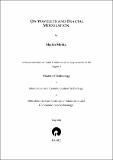On wavelets and fractal modulation
Abstract
The thesis considers a communication problem - that of communicating over a channel having simultaneously unknown bandwidth and unknown duration. As a solution to this problem, the thesis looks into a modulation scheme - Fractal Modulation - proposed by Gregory Wornell and Alan Oppenheim.
Wornell and Oppenheim have observed that requirements of reliable communication over such a channel can be met using ‘scale-diversity’ (transmitting the information at multiple time-scales). To achieve this scale-diversity, they have proposed the use of a particular class of self similar signals, called bihomogeneous signals. They have developed an inner product space representation of bihomogeneous signals. This representation stems from dyadic orhthonormal wavelet based expansion of bihomogeneous signals. Apart from providing very natural and convenient framework of signal representation, these wavelet based expansions lead to efficient algorithms for analysis and synthesis of these signals.
This thesis critically analyzes links between important concepts of the general communication problem, the bihomogeneous signal model and wavelet based signal-processing methods. In the process, we have been able to achieve an understanding of the role of bihomogeneous signals and wavelet-based signal processing techniques in providing elegant and efficient solution to this unconventional problem. During the course of the thesis, we could implement and simulate the transmitter part of the complete communication system (transmitter, channel model and receiver). MATLAB was used for this purpose. The thesis presents implementation and simulation of algorithms for synthesizing channel waveform for Fractal Modulation scheme. The results of the simulation corroborate those expected from theoretical treatment.
Collections
- M Tech Dissertations [923]

